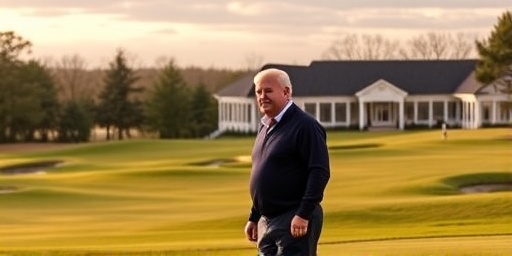In a surprising move blending politics, sports, and military heritage, President Donald Trump has announced a high-profile partnership with golf legend Jack Nicklaus to overhaul the iconic golf courses at Joint Base Andrews. The initiative, dubbed the ‘Presidential Golf Course Revamp,’ aims to modernize the facilities long favored by U.S. presidents, but it has already sparked debates over taxpayer dollars and the appropriateness of such projects on federal military land.
The White House revealed the collaboration during a press briefing on Tuesday, highlighting how Trump’s personal passion for golf intersects with Nicklaus’s unparalleled expertise in course design. Trump, an avid golfer himself, has frequently played at the Andrews courses, which have hosted dignitaries and leaders for decades. This renovation project promises to elevate the site into a world-class venue while preserving its historical charm, but critics question whether military resources should prioritize leisure over defense needs.
Nicklaus’s Blueprint: Elevating Andrews to Elite Status
Jack Nicklaus, the 18-time major champion often called the ‘Golden Bear,’ brings a storied legacy to the table. With over 100 course designs worldwide, including legendary layouts like Muirfield Village, Nicklaus’s involvement signals a commitment to excellence. In an exclusive statement to reporters, Nicklaus expressed enthusiasm for the project: “The golf courses at Joint Base Andrews aren’t just patches of green—they’re part of American history. Working with President Trump, we’ll blend timeless tradition with modern innovation to create something truly special.”
The renovation plans, detailed in preliminary White House documents, include upgrading the 18-hole championship course and the accompanying 9-hole executive layout. Key enhancements involve reshaping bunkers for better playability, installing advanced irrigation systems to combat climate challenges, and incorporating sustainable features like drought-resistant grasses. Engineers estimate the project could cost upwards of $10 million, drawing on Nicklaus’s firm, Nicklaus Design, for the architectural oversight.
Historically, the Andrews golf course has been a staple since the 1950s, when it was established to provide recreation for Air Force personnel and visiting VIPs. Presidents from Eisenhower to Obama have teed off there, making it a symbolic retreat amid the pressures of the Oval Office. Trump’s partnership with Nicklaus aims to restore faded elements, such as the original fairways that have weathered years of use, while adding luxury touches like improved clubhouses and practice facilities.
Experts in golf architecture praise the potential impact. Tom Doak, a renowned course designer, noted in a recent interview, “Nicklaus’s touch could turn Andrews into a bucket-list destination, even if access remains restricted. It’s a smart way to honor military service through recreation.” However, the project’s scale raises eyebrows—similar renovations at private clubs have run into the tens of millions, and federal oversight will be crucial to keep costs in check.
Funding Scrutiny: Taxpayer Dollars on the Tee
At the heart of the controversy is how this ambitious golf course upgrade at Joint Base Andrews will be financed. The White House has proposed a mix of public and private funding, with initial allocations from the Department of Defense’s morale, welfare, and recreation budget. Trump emphasized during the announcement, “This isn’t about extravagance; it’s about giving our troops and leaders the best facilities possible. Jack Nicklaus is donating his time—now that’s American spirit.”
Yet, fiscal watchdogs are sounding alarms. The Project On Government Oversight (POGO) released a statement questioning the priority: “With defense budgets stretched thin amid global tensions, spending millions on a presidential golf course feels tone-deaf. Joint Base Andrews serves critical national security functions—why divert resources here?” Preliminary estimates peg the total at $8-12 million, covering not just design but also environmental assessments and construction phased over two years.
Potential funding sources include congressional appropriations, partnerships with golf industry sponsors, and even contributions from Trump’s personal network of donors. Nicklaus, whose net worth exceeds $400 million, has hinted at pro bono elements, but details remain vague. A breakdown from White House briefings outlines:
- Design and Planning: $2 million, led by Nicklaus Design with input from military engineers.
- Construction: $6-8 million for earthmoving, turf installation, and infrastructure.
- Sustainability Upgrades: $1-2 million for water conservation and eco-friendly materials, aligning with broader federal green initiatives.
Congressional hearings are expected in the coming months, where lawmakers from both parties will grill officials on cost-benefit analyses. Democrats, in particular, have cited Trump’s past golf outings—estimated at over 300 rounds during his first term—as evidence of favoritism. “Renovating a golf course while veterans wait for benefits? That’s not leadership,” said Sen. Elizabeth Warren in a tweet responding to the news.
Military Property Debates: Balancing Recreation and Readiness
Joint Base Andrews, home to Air Force One and a hub for presidential travel, isn’t just any military installation—it’s a symbol of American power. Using its grounds for a golf course renovation amplifies concerns about the militarization of leisure. The base’s 19-hole setup, including the President’s Course, has long provided stress relief for service members, but expanding it under Trump’s directive invites scrutiny over land use policies.
Defense experts point to precedents: The Pentagon has invested in recreational facilities to boost troop morale, with over $1 billion annually allocated to MWR programs nationwide. A 2022 Government Accountability Office report highlighted how such amenities reduce PTSD rates by 15% among participants. Proponents argue the Andrews project fits this mold, potentially serving 5,000 active-duty personnel and their families.
However, environmental and security advocates worry about disruptions. The base’s proximity to Washington, D.C., means construction could interfere with flight operations or sensitive areas. The Sierra Club has called for a full environmental impact statement, noting potential habitat disruption for local wildlife. “Military bases are for defense, not luxury sports,” said a club representative.
Trump’s history with golf adds layers to the narrative. His ownership of Trump National Golf Club in Virginia has drawn parallels, with critics accusing him of blurring public and private interests. White House officials counter that Nicklaus’s involvement ensures professionalism, distancing it from any personal gain. Base commander Col. Gina Sabric issued a supportive memo: “This upgrade will enhance our community’s well-being without compromising mission readiness.”
Reactions Pour In: From Golf Fans to Political Foes
The announcement has elicited a spectrum of responses, underscoring the polarized lens through which Trump’s actions are viewed. Golf enthusiasts are thrilled; the PGA of America congratulated the duo, stating, “A Nicklaus-designed course at Andrews could inspire the next generation of players, especially those in uniform.” Social media buzzes with hashtags like #TrumpNicklaus and #AndrewsRevamp, amassing over 50,000 mentions in the first 24 hours.
On the political front, reactions are sharper. House Speaker Nancy Pelosi dismissed it as “another vanity project,” while Republican allies like Sen. Lindsey Graham praised it as “a win for morale and American excellence.” Bipartisan voices, including veterans’ groups like the American Legion, urge caution: “Recreation matters, but only if it’s funded transparently and prioritizes service members over celebrities.”
Public opinion polls, such as a quick snap survey by Quinnipiac University, show 52% approval among golf fans but only 38% overall, with funding cited as the top concern. Media coverage varies—Fox News hails it as innovative, while CNN probes potential conflicts of interest tied to Trump’s golfing habits.
Nicklaus, staying above the fray, focused on the positives in a Golf Digest interview: “I’ve designed courses for presidents before, but this one hits home. It’s about legacy—Trump’s for the nation, mine for the game.” The partnership also spotlights broader trends: Golf’s growing role in diplomacy, from Nixon’s ping-pong to modern summits on the links.
Looking Ahead: Timeline, Legacy, and Lasting Impact
As shovels prepare to break ground by late 2024, the Joint Base Andrews renovation stands poised to redefine presidential recreation. White House projections outline a 24-month timeline, with Phase 1 focusing on the main course’s front nine by summer 2025. Completion could coincide with the 2026 midterms, offering Trump a tangible achievement to tout.
Beyond aesthetics, the project could set precedents for future military investments. If successful, similar upgrades might roll out to bases like Camp David or Quantico, integrating Nicklaus’s sustainable designs to address climate resilience. Economically, it could boost local Maryland vendors, with construction jobs estimated at 200-300 positions.
Yet, unresolved questions linger: Will oversight bodies approve the budget? How will access be managed for non-military users? And in an era of fiscal austerity, does this golf course symbolize smart stewardship or misplaced priorities? As Donald Trump and Jack Nicklaus swing into action, the nation watches—tee shots and all—to see if this partnership drives home a hole-in-one for morale or veers into rough territory.
The implications extend to Trump’s post-presidency influence, potentially cementing his mark on American pastimes. With the White House emphasizing inclusivity for troops, the revamped courses could become a neutral ground for bipartisan bonding, fostering unity one fairway at a time. Stakeholders anticipate ribbon-cutting ceremonies that blend ceremony with competition, perhaps even hosting invitational tournaments for wounded warriors.
In the broader context of national service, this initiative underscores golf’s therapeutic value—studies from the VA show it aids rehabilitation for 70% of participants. If executed well, the Andrews golf course could emerge as a beacon of resilience, proving that even amid debates, strategic investments in well-being strengthen the force.









